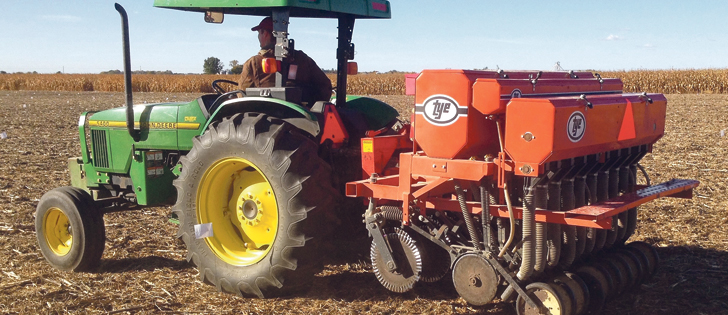With Iowa farmland at $8,500 per acre and corn at US$3.25 per bushel, squeezing out more per acre is the goal
Farmers in a corn and soybean rotation have long recognized the benefit of a cover crop to prevent erosion, but their cover crop seeding window typically slams shut before harvest is complete.
This soil erosion dilemma is compounded by the fact that corn stover is removed from the field be-cause of its dollar value as livestock feed and, more significantly, as a renewable biofuel in producing cellulosic ethanol.
If left on the field surface, cornhusks, stems and leaves would protect the soil.
However, farming is a business, so stover gets baled.
Read Also

Soybean market still figuring out implications of China-U.S. pact
Soybean futures had a muted reaction to the U.S. trade deal with China as the market tries to figure out the nuances of the deal.
The obvious answer to the dilemma is to have a cover crop already growing between the corn rows during the summer, so it’s ready to take off and grow again after the bales are gone. The obvious next question is where to find such a cover crop?
That’s a question into which researcher Cynthia Bartel has been delving the past two years. She is working toward her PhD at Iowa State University.
In reviewing previous corn cover crop research, she decided there were still numerous unexplored opportunities in seeding perennial grasses between corn rows.
She said she wanted to find grass varieties that would reliably establish and grow adjacent to corn, go dormant in the summer when corn needs all the moisture and nutrients it can find and then pop up again and grow some more before freeze-up.
Another factor high on her list of criteria was that any cover or companion crop must improve soil quality.
“We envision that perennial grass seed might be purchased and planted only every four to five years, which would greatly reduce expenses compared to annual cover crops,” Bartel said.
“The success of the system largely depends on using a compatible species.”
With Iowa farmland selling for US$8,500 per acre and more, Bartel knew there was no way corn growers could afford to take land out of production to establish a perennial cover crop. Any potential cover crop had to be planted and established at the same time as the corn.
Her team conducted the field study at two locations: the university’s Agronomy and Agricultural Engineering Sorenson Research Farm at Ames and the Northern Research Farm in Kanawha, 120 kilometres north of Ames.
At the Kanawha farm, grass and corn were planted at the same time. At the Ames farm, they tried to establish grass first but were forced to over-seed grass while they planted corn because of poor grass emergence.
Each farm had 36 plots for the establishment of grass cover in corn and 36 plots for the establishment of grass cover in soybeans. Everything was planted on 30-inch row centres.
They planted Kentucky bluegrass in some plots and creeping red fescue in others.
The older grass varieties selected for the project failed to establish, while the modern grass varieties stayed green too long into the corn season.
At both locations, grass seeding was done with a Tye Pasture Pleaser and corn and soybeans with a John Deere 7100 planter.
“Where the grasses established properly, weed suppression was a definite benefit to using a living mulch,” Bartel said.
“It wasn’t as much of a factor in the first year while the grasses were getting a start.”
Corn and grass are in the same family, leading to questions about whether this cover crop would contribute to weed and disease problems. Would it have been better to experiment with a broadleaf cover crop?
“Corn is a C4 warm season grass species. We chose the C3 cool season grass species because we thought it might have genetic traits that would make it more compatible with corn,” Bartel said.
“C3 has an inherent summer dormancy, which is something we need, and it has a faster green-up in the spring, which is good for nitrate recycling and reduction of leeching. It has a tolerance for living in the shade of a row crop canopy. Plus, it’s low-growing, so it won’t shade out young corn and soybean seedlings.”
Corn and grass are genetically similar, but Bartel said it would still be prudent to use caution in selecting chemicals for weed control. She said it’s been documented by other researchers that a living mulch like this can be very effective in weed suppression.
However, it’s still not known whether the living mulch has enough impact to reduce the number of chemical applications.
Bartel said grain yield was slightly less in the first year because the grass was getting a toe hold. In the second year, control corn and the grass cover corn had similar yields. The grass did not affect stover quality by the second year or stover quantity in either year.
“Ultimately, there may be a first-year yield penalty for perennial grass establishment in exchange for the natural resources benefits, but refining the system further to ensure compatibility between the row crop and grass cover species should largely minimize that penalty,” she said.
“We identified key challenges in varietal selection to ensure that further research efforts are focused effectively. This could very well become a common practice in the future. Right now we’re in the very beginning stages of this concept. We’re at the ‘don’t try this at home’ stage right now.”
















